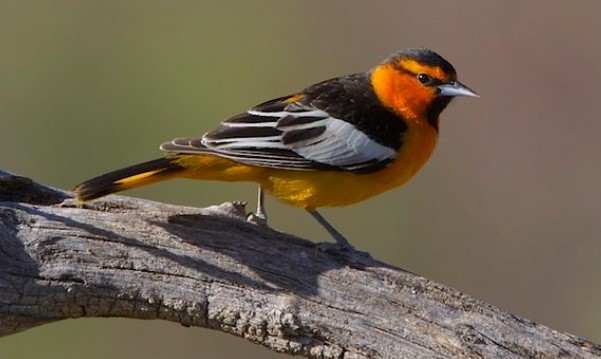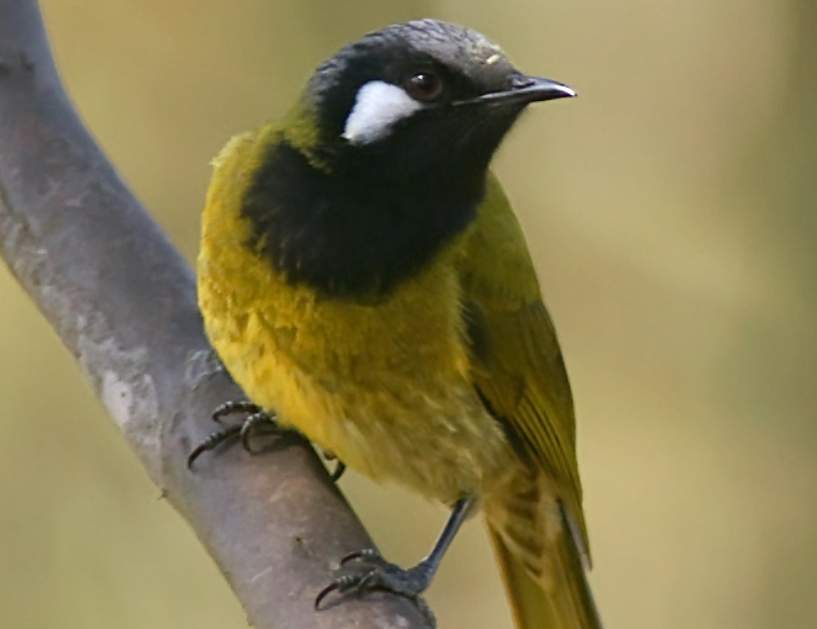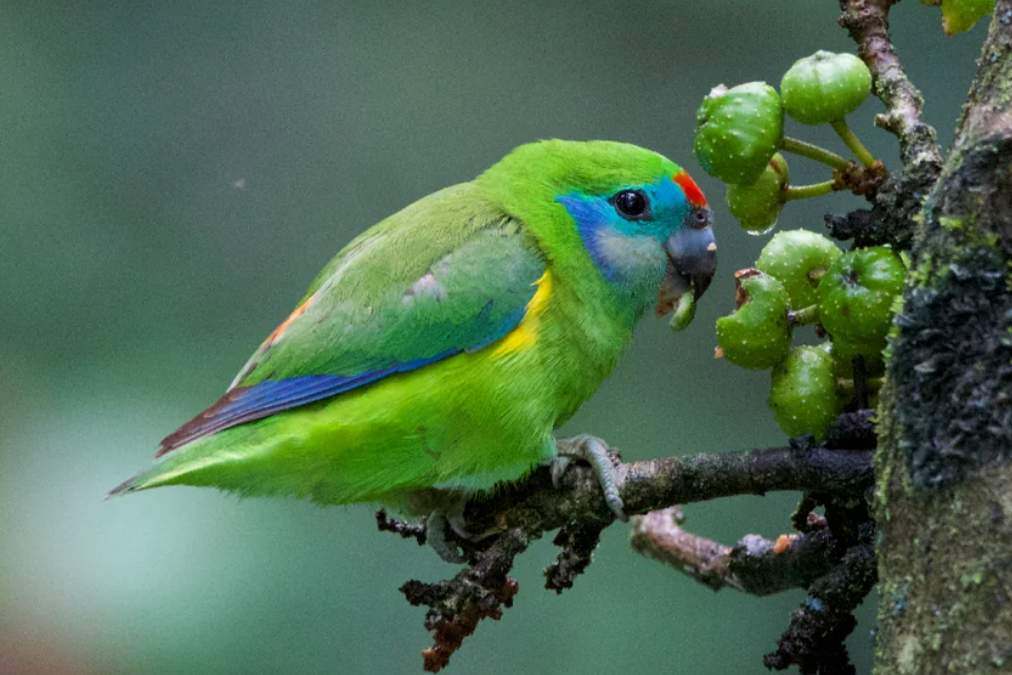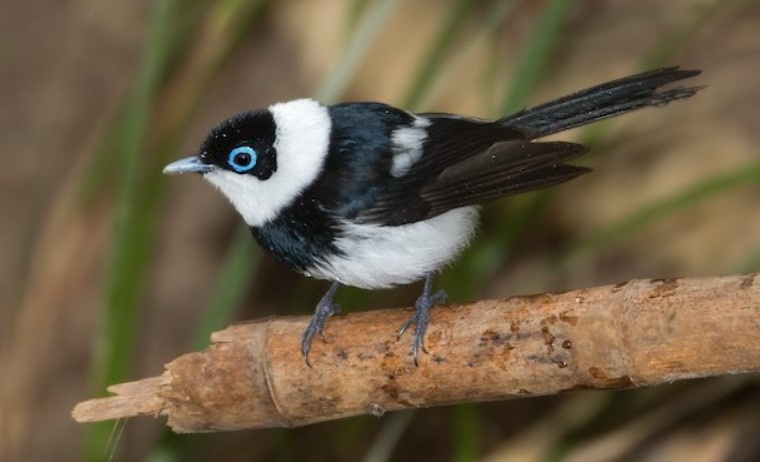Physical characteristics: Bullock’s Oriole is a species of bird in the family Icteridae, native to North America. It is a medium-sized bird, typically measuring around 7-8 inches in length, with distinctive plumage, including a bright orange head, back, and breast, and black wings and tail, and weighing between 1 and 1.5 ounces. They have a wingspan of about 11 inches and a distinctive shape, with a slightly rounded head, a long, thin beak, and a plump body. Their wings are long and pointed, allowing them to maneuver easily through the trees in search of food and mates.
They are often found in open woodlands, parks, and gardens and feed primarily on insects and nectar. In the spring and summer, they build pendulous nests made of woven grasses that hang from the branches of trees. Bullock’s Orioles are known for their agility and dexterity, which they use to cling to and move about in the branches of trees.
They are also strong fliers, with the ability to travel long distances during migration and navigate through dense forests in search of food and mates. Overall, the combination of their bright colors, energetic behavior, and strong flight capabilities makes Bullock’s Orioles an important and fascinating component of the North American bird community.
Bullock’s oriole female: The female Bullock’s oriole is similar in size to the male but has less colorful plumage. Instead of the bright orange head, back, and breast of the male, the female Bullock’s Oriole is mostly yellowish-green with a lighter yellow underside. They have a streaked brown back, black wings and tail, and a yellow-orange wash on their flanks. While they may not have the striking appearance of the male, female Bullock’s Orioles are important members of their breeding pair and play an essential role in caring for their young.
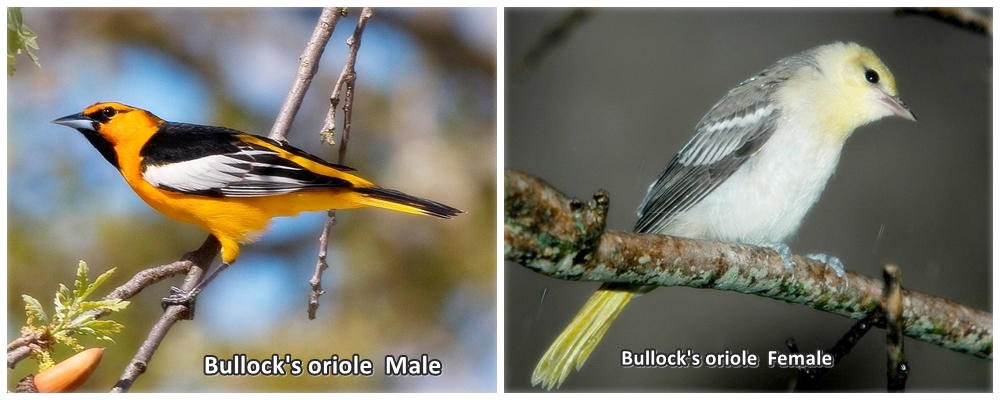
Feathers: The feathers of Bullock’s Orioles are brightly colored, with males sporting striking black and orange plumage, while females have a more muted greenish-yellow plumage. These bright colors serve as visual cues that help the birds attract mates and defend their territories, as well as making them easier to spot in the trees and shrubs where they live.
Bullock’s Oriole Call, Song, Sounds, Alarm Call: Bullock’s Orioles are known for their sweet, flute-like songs, which are a characteristic feature of their breeding territory. They use their songs to communicate and defend their territory from other birds. The songs of Bullock’s Orioles are made up of a series of high-pitched, melodic trills and chirps, which can be heard from a considerable distance.
In addition to their songs, Bullock’s Orioles also make a variety of other vocalizations, including calls and alarm calls. Their calls are shorter and more abrupt than their songs and are used to communicate with their mate or to attract their attention. Their alarm calls are higher-pitched and more urgent than their other vocalizations and are used to warn of potential danger. Overall, the vocalizations of Bullock’s Orioles play an important role in their behavior and communication, and their sweet songs are a defining characteristic of their species.

Bullock’s oriole range: Bullock’s orioles are found in North America, primarily in the western United States and northern Mexico. Their range extends from the Pacific coast to the Great Plains and includes parts of California, Nevada, Utah, Arizona, Colorado, and New Mexico. They are also found in smaller numbers in parts of western Texas, Oklahoma, Kansas, and Nebraska.
In the winter, some populations of Bullock’s Orioles migrate to Mexico, where they can be found in the tropical deciduous forests and thorn forests of central and southern Mexico. During the breeding season, they occupy a wide range of habitats, including open woodlands, parks, and gardens.
Bullock’s orioles are highly adaptable birds, and their range has expanded in recent years due to the availability of suitable habitats and the abundance of food sources in urban and suburban areas. However, their populations may be declining in some areas due to habitat loss and other environmental pressures, so it’s important to protect their habitats and ensure that they have access to the food and nesting sites they need to thrive.
Breeding and Nesting: Bullock’s Orioles are known for their monogamous mating habits, with a breeding season that lasts from May to July. The exact start of the breeding season may vary based on location, with a later onset in more northern and western regions. Both males and females take part in the construction of a pendulous nest, made from plant fibers and sometimes animal hair and lined with down, hair, and moss. They lay between 3-6 eggs, and both parents work together to raise and protect the young. These birds may hybridize with Baltimore Orioles in areas where their ranges overlap in the Midwest.
Diet: Bullock’s orioles are omnivorous birds, feeding on a variety of food items throughout the year. During the breeding season, they feed on insects, such as caterpillars, beetles, and flies, as well as spiders. They also feed on nectar and fruit, including berries, cherries, and oranges. In the winter, they rely more heavily on fruit, as insects are less abundant.
Habitats: Bullock’s Orioles occupy a wide range of habitats, including open woodlands, parks, gardens, and suburban areas. They are highly adaptable and can thrive in a variety of environments, as long as they have access to food and suitable nesting sites. During the breeding season, they build their nests in the branches of trees, often in tall, deciduous trees or shrubs. The nests are woven from grasses, fibers, and animal hair and are typically suspended from a single branch.
Behavior: In terms of behavior, Bullock’s Orioles are energetic and active birds, flitting from tree to tree in search of food and mates. They are territorial during the breeding season, using their songs and calls to defend their territory from other birds. They are also known for their playful behavior, such as swinging from the branches of trees or “bouncing” from one branch to another. In general, Bullock’s Orioles are fascinating birds to watch and are a valuable component of North American ecosystems.
Related Species: Bullock’s Orioles are members of the family Icteridae, which includes many other species of North and South American orioles. They are most closely related to the Baltimore Oriole, which is a closely related species that is also found in North America. Other closely related species include the Scott’s Oriole, which is found in the southwestern United States and Mexico, and the Orchard Oriole, which is found in the eastern and central United States and Canada.
In addition to these closely related species, there are many other species of orioles found throughout the Americas, including the Hooded Oriole, which is found in the southwestern United States and Mexico, and the Spot-breasted Oriole, which is found in Central America and parts of South America. These species, along with Bullock’s Orioles, form a diverse and fascinating group of birds that are valued for their bright colors, melodious songs, and unique behaviors.
